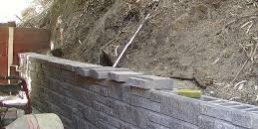When land is excavated or an embankment is filled, the surrounding soil can collapse in the absence of a well-built retaining wall. Not only do retaining walls prevent erosion and the wash-out of soil, but can also be a vital tool in the protection of a home or commercial property. Without one, a soil collapse can cause significant property damage and injury; with an improperly built retaining wall, damage can be even more significant as the soil collapses and carries the materials used to construct the unsound wall along the way.
Building Retaining Walls
Retaining walls can be constructed from a wide variety of materials, including timber, concrete, stone and bricks. Timber is a popular choice for aesthetic reasons, but it’s important for home and business owners to note that timber logs will be weakened over time by moisture present in the soil, but timber can also reinforce new concrete to protect against soil collapse.
A basic understanding of the laws of gravity is important, both when building new retaining walls and evaluating existing structures, as it does relate directly to the viability of the structure overall. Retaining walls are built to keep heavy organic material from falling, according to the laws of gravity. The pressure exerted by the soil is substantial, and the pressure will increase when the soil is wet. This can cause the wall to overturn, move forward over time, or even to completely collapse.
Structural stability is greatly compromised when proper drainage is overlooked during construction, not only as a result of added weight from the water but also because excessive moisture within the soil can cause water uplift significantly. The pressure exerted by water, hydrostatic pressure, can cause failure of an otherwise healthy retaining wall if drainage concerns are not taken into consideration.
How Retaining Walls Affect the Purchase or Sale of a Property
Commonly, retaining walls are built on or very near the boundary line of a property. During the sale or purchase of a property upon which a retaining wall has been built, the wall itself can become the source of boundary disputes and legal battles. In the event of a retaining wall collapse, two parties may also be in disagreement about to whom the responsibility of repair or replacement belongs. Property disputes can severely complicate the sale or purchase process, so it’s always wise to have a clear understanding of property boundaries in relation to existing retaining walls.
The best way for homeowners and prospective buyers to protect themselves is to work with a registered building inspection company which also handles property boundary dispute resolution cases. As a neutral third party with no financial stake in either the condition of an existing retaining wall or upon whose property it rests, a registered building inspector from a reputable company can evaluate the overall health and soundness of the structure while arbitrating any disputes about to whom the wall belongs. By working with a registered building inspection company, you can help to minimise the risk of a collapsed or overturned retaining wall on your property causing serious damage or injury.
Houspect Building Inspections– Buy, Build, Invest and Sell with Confidence







